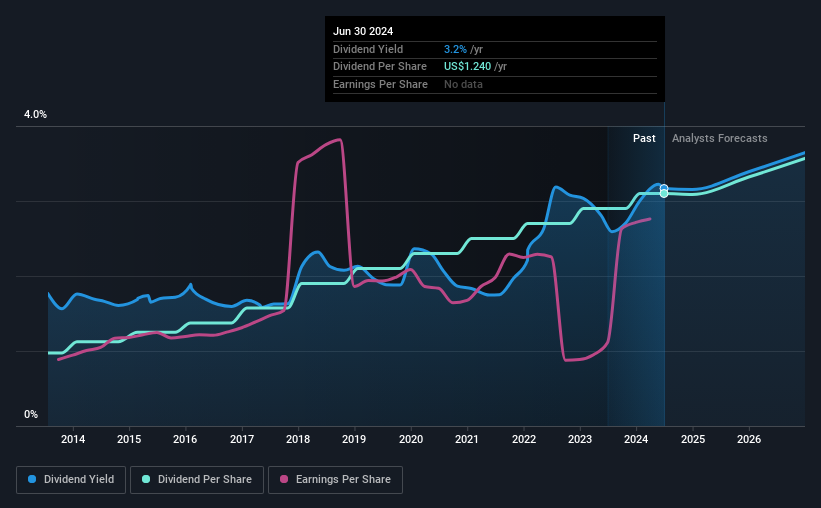Why You Might Be Interested In Comcast Corporation (NASDAQ:CMCSA) For Its Upcoming Dividend
Some investors rely on dividends for growing their wealth, and if you're one of those dividend sleuths, you might be intrigued to know that Comcast Corporation (NASDAQ:CMCSA) is about to go ex-dividend in just two days. The ex-dividend date is usually set to be one business day before the record date which is the cut-off date on which you must be present on the company's books as a shareholder in order to receive the dividend. It is important to be aware of the ex-dividend date because any trade on the stock needs to have been settled on or before the record date. This means that investors who purchase Comcast's shares on or after the 3rd of July will not receive the dividend, which will be paid on the 24th of July.
The company's next dividend payment will be US$0.31 per share. Last year, in total, the company distributed US$1.24 to shareholders. Based on the last year's worth of payments, Comcast stock has a trailing yield of around 3.2% on the current share price of US$39.16. Dividends are a major contributor to investment returns for long term holders, but only if the dividend continues to be paid. So we need to check whether the dividend payments are covered, and if earnings are growing.
Check out our latest analysis for Comcast
Dividends are typically paid out of company income, so if a company pays out more than it earned, its dividend is usually at a higher risk of being cut. That's why it's good to see Comcast paying out a modest 31% of its earnings. A useful secondary check can be to evaluate whether Comcast generated enough free cash flow to afford its dividend. Thankfully its dividend payments took up just 35% of the free cash flow it generated, which is a comfortable payout ratio.
It's positive to see that Comcast's dividend is covered by both profits and cash flow, since this is generally a sign that the dividend is sustainable, and a lower payout ratio usually suggests a greater margin of safety before the dividend gets cut.
Click here to see the company's payout ratio, plus analyst estimates of its future dividends.
Have Earnings And Dividends Been Growing?
Businesses with strong growth prospects usually make the best dividend payers, because it's easier to grow dividends when earnings per share are improving. If earnings decline and the company is forced to cut its dividend, investors could watch the value of their investment go up in smoke. This is why it's a relief to see Comcast earnings per share are up 8.9% per annum over the last five years. The company is retaining more than half of its earnings within the business, and it has been growing earnings at a decent rate. We think this is generally an attractive combination, as dividends can grow through a combination of earnings growth and or a higher payout ratio over time.
Another key way to measure a company's dividend prospects is by measuring its historical rate of dividend growth. Comcast has delivered an average of 12% per year annual increase in its dividend, based on the past 10 years of dividend payments. We're glad to see dividends rising alongside earnings over a number of years, which may be a sign the company intends to share the growth with shareholders.
The Bottom Line
From a dividend perspective, should investors buy or avoid Comcast? Earnings per share have been growing moderately, and Comcast is paying out less than half its earnings and cash flow as dividends, which is an attractive combination as it suggests the company is investing in growth. It might be nice to see earnings growing faster, but Comcast is being conservative with its dividend payouts and could still perform reasonably over the long run. There's a lot to like about Comcast, and we would prioritise taking a closer look at it.
In light of that, while Comcast has an appealing dividend, it's worth knowing the risks involved with this stock. In terms of investment risks, we've identified 1 warning sign with Comcast and understanding them should be part of your investment process.
A common investing mistake is buying the first interesting stock you see. Here you can find a full list of high-yield dividend stocks.
Have feedback on this article? Concerned about the content? Get in touch with us directly. Alternatively, email editorial-team (at) simplywallst.com.
This article by Simply Wall St is general in nature. We provide commentary based on historical data and analyst forecasts only using an unbiased methodology and our articles are not intended to be financial advice. It does not constitute a recommendation to buy or sell any stock, and does not take account of your objectives, or your financial situation. We aim to bring you long-term focused analysis driven by fundamental data. Note that our analysis may not factor in the latest price-sensitive company announcements or qualitative material. Simply Wall St has no position in any stocks mentioned.
Have feedback on this article? Concerned about the content? Get in touch with us directly. Alternatively, email editorial-team@simplywallst.com

 Yahoo Finance
Yahoo Finance 
